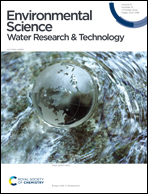Water decontamination under high salinity using the TiO2 NT/PbO2–Cu electrochemical oxidation system: kinetics mechanism and DFT studies†
Abstract
The increasing need for water decontamination under high salinity conditions calls for alternative processes with high efficiency and cost-effective performance, of which electrochemical technologies hold continuous attraction. Compared to several studies under chloride background, contaminant degradation in high sulfate concentrations using electrochemical methods has rarely been studied. In this study, a facile and cost-effective TiO2 nanotube (NT) electrode, coated with a PbO2 layer was fabricated to serve as an anode to degrade the selected contaminant under the condition of high sulfate concentration. 100% removal of 0.05 mM 2,4-dichlorophenol (2,4-DCP) was achieved within 50 minutes at a relatively low current density. Degradation of 2,4-DCP followed pseudo-first-order kinetics in the electrochemical system, and the parameter of current density was proved to have the biggest effect on the pollutant removal performance compared to pH and salt concentrations. The mechanism of 2,4-DCP degradation followed the radical and direct electron transfer (DET) pathways. Even though the sulfate radical was generated in water containing high sulfate, the theoretical energy barrier calculated from density functional theory (DFT) simulation indicates the priority of hydroxyl radical on pollutant degradation, and the comparison of reaction energy based on experiments and DFT also suggested that the sulfate radical is more prone to act as a precursor for more hydroxyl radical formation. The degradation performance under various salt conditions was also investigated in this study. High content of chloride in water resulted in extremely fast removal performance, while high content of nitrate in water resulted in the apparent inhibition of pollutant removal. The as-made electrodes exhibited excellent performance for the degradation of different contaminants and reliable stability after rounds of use. This study provides an insight into the application of an electrochemical oxidation system in high salinity wastewater treatment.



 Please wait while we load your content...
Please wait while we load your content...